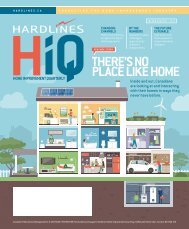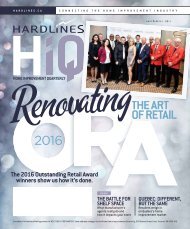HHIQ Q2
You also want an ePaper? Increase the reach of your titles
YUMPU automatically turns print PDFs into web optimized ePapers that Google loves.
COVER FEATURE<br />
FEATURE<br />
What brands<br />
really resonate<br />
with consumers?<br />
According to Anthony Stokan of<br />
Anthony Russell and Associates, over<br />
the past few decades, the list of the top<br />
Canadian brands included names like<br />
Tim Horton’s, Canadian Tire, Roots and<br />
President’s Choice. But recent studies<br />
show that the most influenital brands<br />
in the country are as follows:<br />
1. Google<br />
2. Facebook<br />
3. Apple<br />
4. Amazon<br />
5. Microsoft<br />
What does this mean about the<br />
marketplace? Stokan suggests that<br />
it’s tough to be a top brand in North<br />
America because so much is happening<br />
in the world. As we shift to a globalized<br />
experience, companies need to have<br />
penetration in up to 80 to 100 countries.<br />
Stokan also cites recent research<br />
polling North American millennials<br />
about their top-rated brands. They<br />
ranked them as:<br />
1. Netflix<br />
2. Facebook<br />
3. Walmart<br />
4. iPhone<br />
5. Instagram<br />
Again, almost all these companies<br />
are technology or web-based. But<br />
they facilitate connection, whether<br />
through sharing content, images,<br />
messages or life updates. This is<br />
how young people are relating to the<br />
world outside themselves these days.<br />
Retailers are wise to leverage social<br />
media activity in their branding and<br />
marketing strategies.<br />
LIVE YOUR BRAND FULLY<br />
The home improvement retailers best positioned<br />
to consistently deliver on that brand<br />
promise, according to Steve Buckle, president<br />
of Sexton Group, are independents.<br />
“The greatest brand attribute any business<br />
can have is one I think the independent<br />
building supply retailer has mastered—the<br />
attribute of responsiveness,” says Buckle.<br />
“That ability, that willingness to respond<br />
to your customers’ needs in a timely<br />
manner. It sounds simple, but we know it’s<br />
very difficult.”<br />
Especially in smaller communities across<br />
the country, many independent home<br />
improvement stores are the biggest enterprise<br />
in town—employing a large number<br />
of residents and nearly single-handedly<br />
bolstering the local economy. When the<br />
community needs something, they’ll turn<br />
to their local hardware or building supply<br />
dealer first. And by and large, these retailers<br />
are responsive to those needs.<br />
“It’s good for the business, too,” says<br />
Buckle. “When they’re engaged as a citizen<br />
and present in the community, not just<br />
talking to their customers as customers,<br />
but fellow citizens, and they’re engaged at<br />
many levels, they understand their customer<br />
at a much deeper level than you<br />
would otherwise.”<br />
The challenge those retailers need to meet<br />
is communicating their brand effectively.<br />
Catherine Vaugh, with Orgill, has spent 15<br />
years working with retailers on their retail<br />
“You have to be offering a<br />
service or a product that<br />
is due to the times: it’s<br />
fashion, it’s a trend, it’s<br />
going to solve problems and<br />
it’s going to help people.<br />
”<br />
— Catherine Vaugh, Orgill<br />
strategies. Vaugh says the most successful<br />
strategy she’s ever seen companies choose<br />
in terms of branding is to pick a direction<br />
and stick to it.<br />
Having worked for Reebok at the start<br />
of her career, she referenced the intense<br />
competition between Reebok and Nike in<br />
the 1970s and 1980s. When Reebok pulled<br />
ahead in the market, Nike took the time<br />
to stop and evaluate to refine their brand.<br />
“They were patient,” says Vaugh. “They<br />
took their time and they were consistent<br />
and steadfast with their direction. They<br />
made a plan, stuck to it, tested it out, made<br />
minor adjustments along the way, but they<br />
believed in it and they made it happen.”<br />
Not every company—especially in the<br />
home improvement industry—has the<br />
resources of multinational corporations<br />
like Nike and Reebok. But Vaugh says the<br />
principles of what makes this strategy winning<br />
works at all levels.<br />
“When we’re talking about building a<br />
brand on a local level or a global level, it<br />
doesn’t really matter,” says Vaugh. “The<br />
path and the traits that you want to follow<br />
are similar—you have to be relevant. You<br />
have to be offering a service or a product<br />
that is due to the times: it’s fashion, it’s a<br />
trend, it’s going to solve problems and it’s<br />
going to help people.”<br />
HOW DO YOU CULTIVATE LOYALTY?<br />
Once you have your brand clearly outlined<br />
and you’ve shared your message, you will<br />
26 SECOND QUARTER / 2019<br />
Hardlines Home Improvement Quarterly<br />
www.hardlines.ca
















